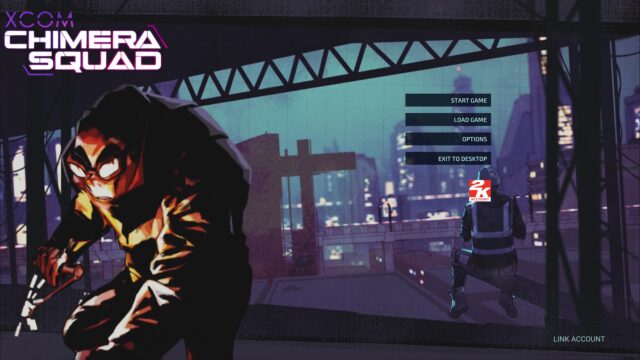Pandora: First Contact Review
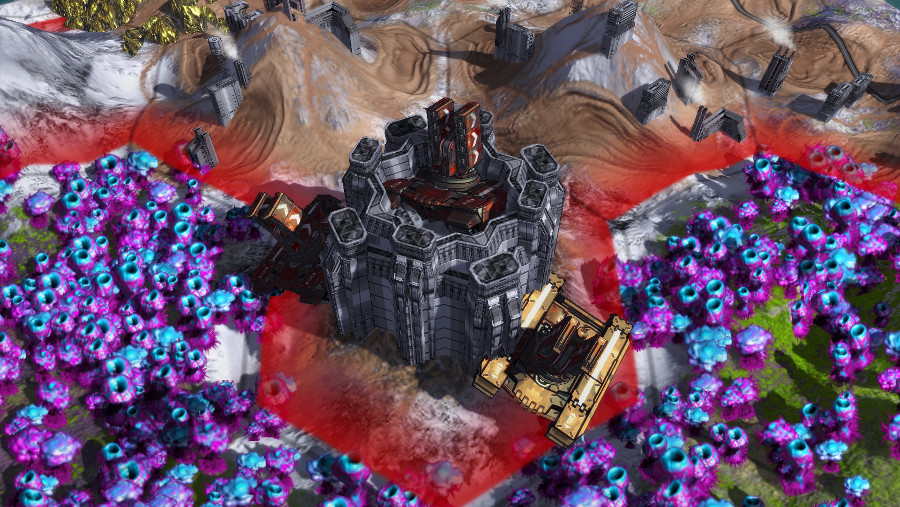
After several months of cryosleep, I finally landed on Pandora – a world teeming with all kinds of wildlife and practically begging for exploration and colonization. The setting and intro stirred up the overgrown pool of my consciousness, throwing in memories of Alpha Centauri, and although it would be unfair to assume that any game could compete with the classic legacy of global strategies, I still hoped that Pandora would be able to satisfy my persistent nostalgic itch. And here’s what I think. Pandora: First Contact – This is a game about escalation. Typically, in all global strategies, you need to travel through maps and navigate through branching upgrade trees to gain superiority over the enemy. Buildings play the role of upgrades – the most noticeable similarity to Civilization – and attach to the city like barnacles, but they are not separate structures that spread their influence outward. Like in other global strategies, everything here can be replaced, reworked, and modernized – until you reach the point where there is nothing left to explore. The altar becomes a tomb, the tomb becomes a temple, the temple becomes a cathedral. The culture branch is fully researched.
Fortunately, Pandora is not just Civilization or Age of Wonders in a sci-fi wrapper. Moreover, it is hardly a peculiar update to Alpha Centauri, as one might think, looking at certain elements. Yes, the game tells the story of how different factions with different ideologies intend to colonize the same planet, and yes, this planet eventually resists the uninvited guests. Pandora’s hostility grows, alien life develops, but this development – barely noticeable but dramatically – differs from the order of upgrades described in the previous paragraph.
The most obvious and potentially controversial innovation in the familiar formula of global strategies is the randomized upgrade tree. Starting a new game, the player can choose the number of tiers that will be visible during the game (by default, two). It is possible to make the next technological step completely invisible, or make the entire tree visible from the very beginning. The default option works well – it allows for short-term planning, but the more distant perspective is shrouded in darkness.

But the technologies themselves are not random. Regardless of what they unlock – be it units, buildings, or operations (more on them below) – they are arranged in tiers, so at the beginning of the game, you always make roughly the same decisions. You won’t be able to research planetary bombardment until one of your engineers invents rocket launchers. On the other hand, the connections between different tiers are random, so it may happen that by researching heavy military technology, you gain access to plant processing, and the development of nuclear weapons may be followed by a brilliant discovery in the field of economics.
Of course, this leads to some completely absurd combinations, but it allows for an interesting look at the whimsical peculiarities that are sometimes accompanied by certain discoveries. Colonists rediscover concepts that have already been discovered – or rather, not the concepts themselves, but the methods that can be applied to the use of materials and atmosphere. I suppose many discoveries happen exactly like that, i.e., completely by chance – take, for example, a person with a chocolate bar in their pocket that melted because they were standing next to a radar (I’m talking about Percy Spencer, who invented the microwave, in case anyone didn’t understand).
In theory, this scheme should work, but in practice, the tech tree ends up being too compact and unlikely to provide the necessary replayability. Yes, in unusual situations, you may need a swift leap along one branch of the tree to achieve a desired or necessary goal, but in most cases, it is much wiser to progress evenly from one tier to another. Randomization would be much more interesting if the game allowed for the possibility of blocking certain technologies – losing access to certain capabilities, factions could acquire some unique specialization. But alas.
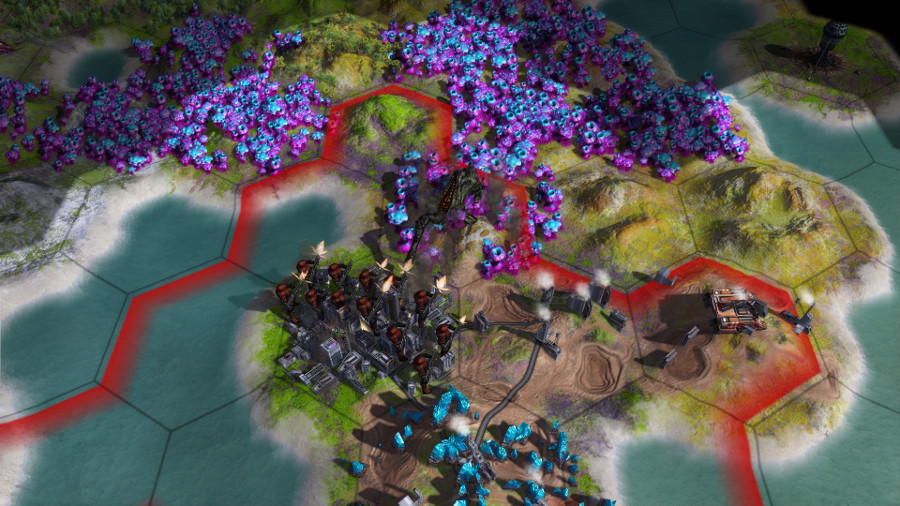
Apart from text messages that elegantly characterize different factions, each of them has several positive and negative abilities that affect the course of events, and they have a much greater impact than usual in strategic games. In addition, messages often appear informing about agreements, alliances, and wars. The diplomacy here is not very complex, but the AI is at least active and can easily disrupt your plans by suddenly demanding or offering something.
Now about the alien life forms. Being in between wandering bears and giant spiders from fantasy global strategies and barbarians from Civilization, the creatures here are the essence and meaning of escalation. It is a cauldron of bubbling biomass with chitinous spikes that threatens to explode at any moment.
At first, they wander back and forth, showing no signs of hostility and only provoking a fight if they dare to block the route to “delicious” territories and alien ruins. The wildlife is divided into several types – from xenomorphs that breed in chewy-pink hives to gigantic monsters that provoke earthquakes as they gallop from one hex to another. There are flying creatures and leviathans living in the depths of the sea. They won’t attack you unless you attack them. They are not united by any collective mind, so individual groups can be shot down without worrying about a deadly onslaught of teeth, claws, and acid.
But the clock is ticking nonetheless. They cannot be heard, but the more the factions grow and the more intensively natural resources are extracted, the closer the hour X approaches. In the end – when habitats are destroyed – the local fauna begins to retaliate. Some technologies allow you to delay the attack, while others provide your units with special means to tame and control the alien fauna.
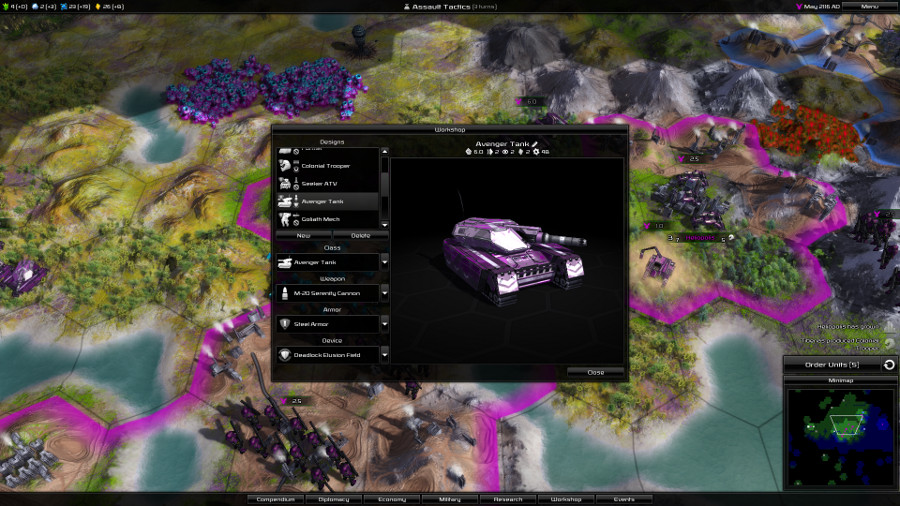
The closer the threat, the stronger the tension – the landscapes begin to swarm with all sorts of creatures. Knowing that major changes are imminent elegantly separates the first stage of the game from all the others, preventing the game from turning into a familiar patient waiting for the end of the turn. Factions strive to control the planet and defeat each other, while resisting attacks and even clearing their native continent of aggressive predators. As a rule, I preferred not to engage in cruel genocide, but to use aliens (although who among us is an alien is another question) as a living minefield through which my enemies had to pass.
The first part of the game progresses swiftly – thanks to rapid development and constant threat from aliens. Pandora does not wait, and the colony grows very quickly. Building structures and management are similar to Alpha Centauri – the local Formers also improve the landscape by building farms or mines on it (although no terraforming is provided), and new research improves cities. Strangely enough, most technologies do not bring immediate improvements – cities need some time to assimilate new knowledge.
Improvements affect the entire faction, but many cities can be controlled, and all acquired resources are not tied to individual settlements, but go to the national “common fund”. This is good for specialization, but it neutralizes positioning and the need for geographical analysis… and yet managing border cities could have become a very interesting gameplay challenge. But cities lack individuality.
Just like the planet itself and the wildlife inhabiting it. Although there are terrifying sea monsters here, other creatures resemble monsters from “Starship Troopers”. Moreover, their appearance quickly begins to be perceived as symbols for one or another indicator of “strength”. Symbols that indicate whether it is worth attacking that swarm of giant beetles or better to avoid it.
And, of course, I had my own “beetles”. Soldiers can be customized – they range from infantry special forces to giant combat machines with weapons and optional slots for armor and gadgets. The set of components is not too large, and they are usually needed to fight biological and mechanical enemies, which means that if you are involved in a war with aliens and several factions, you will definitely have to find a balance. But again, in the end, I simply looked at each of my opponents as a series of numbers and figures.
Operations are usually used during war, but they can also be useful in peacetime. They are unlocked through buildings and research and are one-time effects that can be “reserved” for future use. Some allow for quick exploration of a specific territory, scanning remote areas for “contents”, but even these abilities are better used against enemies – to monitor the location of units and cities. There are operations that can immediately strike at enemies/aliens, while others allow for the enhancement of certain characteristics in a specified area. Operations are constructed using the same resources as units and buildings, so you constantly need to find a balance between the decisions you make, but the main problem with Pandora is that there simply aren’t enough decisions here.
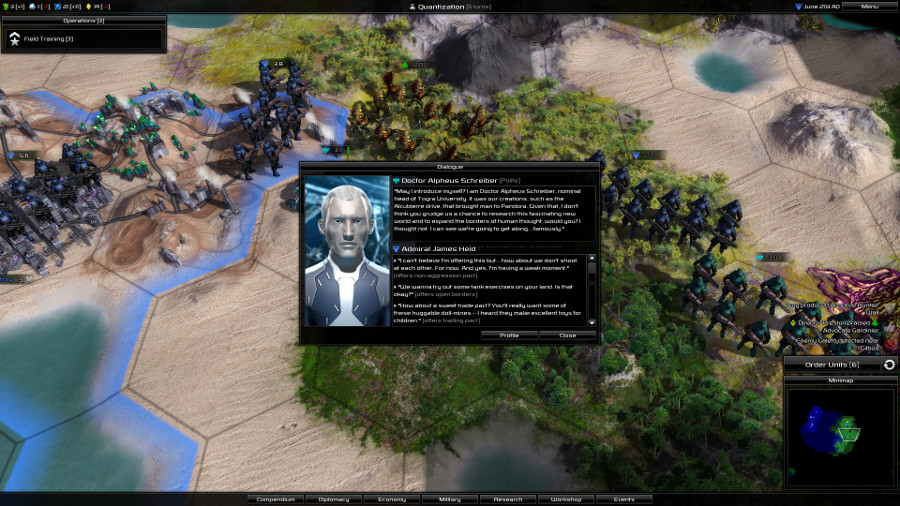
Often one campaign is as similar to another as two drops of water. Rarely did it seem to me that my actions determined the character of the faction I was controlling or somehow influenced the planetary landscape with my presence. I simply played the first stage, before the alien attack, and then held my ground and pushed forward as much as I could on the technological tree to quickly deal with the persistent neighbors.
Despite the decent basic mechanics, there is a lack of individuality and unpredictability here, which turns repeat visits to Pandora into routine. Multiplayer, as usual, brings positive adjustments to this state of affairs, but waiting for someone else’s turn can drag on for a very long time, as is usually the case in such strategies. Moreover, it seemed to me that the factions develop in a similar way, which means that the leader’s decisions and the starting position remain the decisive factors.
However, the game still pleases with pleasant moments. For example, you can be horrified when you come across a continent teeming with alien creatures, to put it mildly, tired of human presence. And once I sent a whole army to the sea and fell into a trap – the nearby islands were filled with ferocious wildlife, and then, as if on cue, a monstrous rose the size of a city emerged from the sea – the last of its kind and extremely angry.
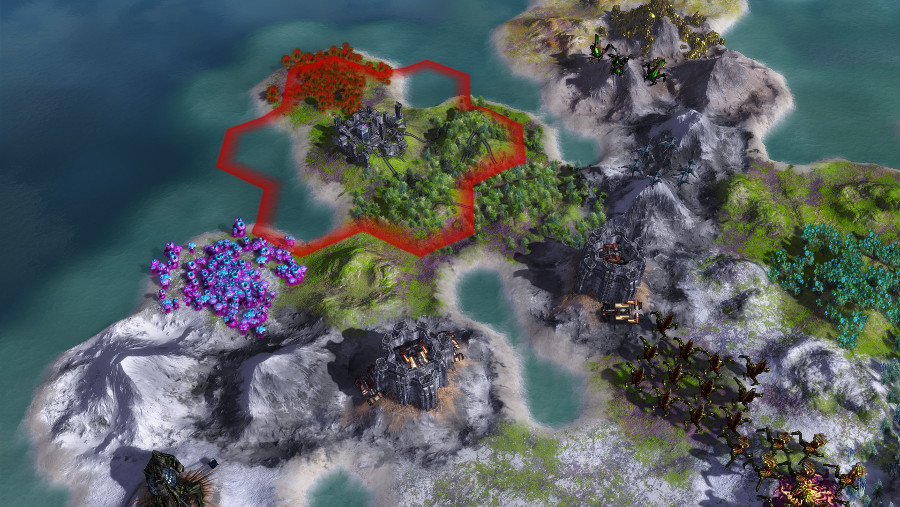
I think that global strategies can be divided into three types, which, of course, partially overlap with each other. The essence of the first type is to improve one’s state machine, gradually leading it to victory, the second type is about exploration and possible imbalance, which means that winning is not always guaranteed, and the third type is about playing a role within a broad context. Pandora falls somewhere between the first two types, but it lacks a real challenge, the developers still have room to strive for. Pandora has a good form, but it is too simple in execution, which means it hardly corresponds to the ambitious and unusual aspects of its structure. And that is disappointing, because the theme – exploration and fierce uprising of the unknown – is perfectly suited for the third “type” of global strategies.
Proof of this is Sid Meier’s Alpha Centauri, which was released almost 15 years ago.
Share
Discuss
More Reviews
